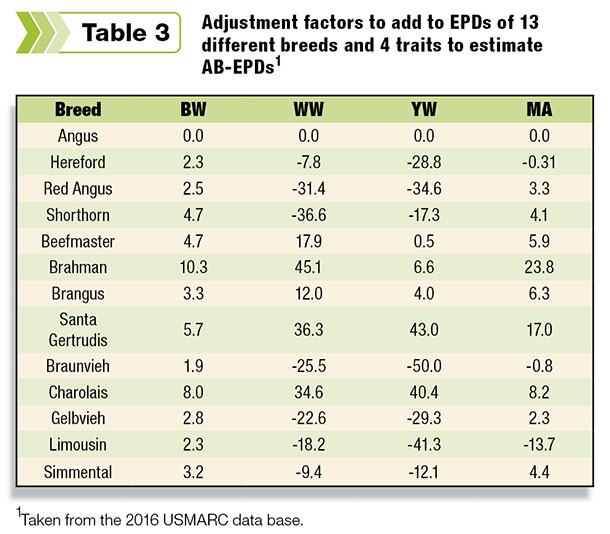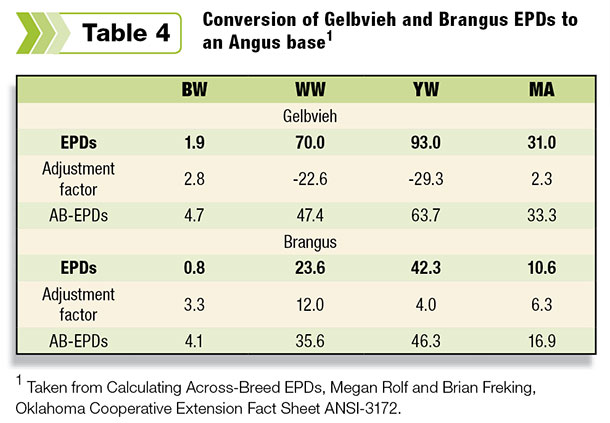One reason for the reluctance of commercial producers to adopt EPDs as a purchasing tool is: They have been told EPDs should not be compared across breeds. EPDs were developed as a measure of genetic merit for comparison within breeds. Since most commercial operations raise crossbred cattle, they need comparisons across breeds when selecting a herd sire.
“Recent research now provides commercial producers with the ability to compare bulls of one breed to those of another breed in a quantitative manner,” says Dr. B.W. Woodward, University of Minnesota. “Across-breed expected progeny differences (AB-EPDs) provide an additional tool to achieve breeding goals that are part of crossbreeding systems."
"Understanding how to use both within- and across-breed EPDs is important for successful production of beef cattle with genetic potential to excel in their production system.”
Within-breed EPDs
A brief review of within-breed EPDs may result in a better understanding of AB-EPDs. EPDs provide a quantitative estimate of an animal’s genetic merit as a parent. They are the prediction of how future progeny (offspring) of each animal are expected to perform relative to the progeny of other animals within the same breed. Some of the genetic traits predicted through EPDs and their measurement units are presented in Table 1.
Click here or on the table above to view it at full size in a new window.
“The actual EPD is calculated using information submitted to the breed associations and provides a prediction for a particular trait of interest for a particular animal,” explains Evan Whitley, Ph.D., of the Samuel Roberts Noble Foundation.
“It is very important to realize that EPDs are not static. They will change over time as more and more progeny information is collected.”
“An EPD is best utilized to compare differences between likely performance of offspring from two selection candidates,” says Megan Rolf, Ph.D., Kansas State University.
“For example, if one bull’s weaning weight EPD is +55.0, and another bull’s EPD is +50, then on an average, the first bull’s offspring should weigh 5 more pounds at weaning than the second bull’s calves. EPDs can also be compared to the average for the entire breed or to the breed’s percentile rankings, which are both published on each breed association’s website.
“An EPD is always paired with a corresponding accuracy value (see Table 1) which ranges from 0 to 1,” Rolf continued. “This value essentially reflects the amount of data used to generate the EPD and how much that EPD could change over time as more data is recorded."
"An accuracy of 0 would reflect no data in the EPD, whereas an accuracy of 1 would indicate that the true breeding value was known. In practice, accuracy values do not appear with values that extreme. Accuracies are sometimes expressed as the accuracy multiplied by 100. For example, an accuracy of 0.15 may be listed as 15.”
The process of using EPDs involves outlining your goals and objectives for the bull to be purchased. This enables you to hone in on those traits that are most important to the operation and therefore will allow you to select a bull that meets those objectives.
“Let’s assume you are a producer who places priority on weaning weight,” suggests Whitley. “You have two bulls to choose from within your chosen breed that will complement your cow herd. The weaning weight EPDs for Bull A and Bull B are 31 and 46 pounds, respectively, and their accuracies are about the same. This means that, on average, Bull B will sire a calf that will wean, at the same age, 15 pounds heavier than calves sired by Bull A when bred to a similar set of cows.”
Before you make your selection, you need another very important piece of information, which is the percentile breakdown charts found in the sire summary for your breed of choice. This chart allows you to look at the breed as a whole and determine where an individual’s EPD fits within the breed. Average EPD values for active sires of several breeds are shown in Table 2.

“Back to our example, Bull B is in the top 10 percent for weaning weight within the breed,” Whitley continues. “The choice is pretty clear, isn’t it, of which sire to attempt to purchase? Perhaps it’s not that simple. We have only looked at one trait for the bull in question.
“Single-trait selection has gotten us into trouble in the past, and we don’t want to revisit history. To avoid extremes in any one trait, be aware of, and comfortable with, all of a bull’s EPDs that are important to you before making the purchase.”
AB-EPDs
“EPDs are not directly comparable across breeds,” says Rolf. “There are ways to compare EPDs across breeds, but it requires an additional step.
“You have to apply an across-breed EPD conversion factor to the EPDs of animals in both breeds to directly compare them. These conversion factors are based upon ongoing comparative breed research at the U.S. Meat Animal Research Center (USMARC) in Clay Center, Nebraska, and allow conversion of EPDs across breeds to a common base. Accuracy of the AB-EPD is similar to the original accuracy of the EPD but with a small amount of additional error associated with the estimation of conversion factors.”
Conversions of EPDs to AB-EPDs can be accomplished in two ways. Option one is to download the current across-breed EPD factors published by USMARC (2016 across-breed EPD table). Some of the factors for 2016 are presented in Table 3.

“The second option is to use the Across-Breed EPD Calculator on the Oklahoma State University Beef Extension website (www.beefextension.com/genetics). Once you are on the website, click on tools and fact sheets,” Rolf says. “The calculator allows up to 20 AB-EPD conversions at one time.
“Manual conversions can be made by taking a within-breed EPD and simply adding the conversion factor to generate the AB-EPD as shown in Table 4.

Conversion factors adjust EPDs to an Angus base, so that AB-EPDs can be directly compared,” explained Roth. “Notice that differences between the two bulls in Table 4 for weaning weight and yearling weight narrowed dramatically after the conversion. Conversion factors often result in a complete re-ranking of bulls between breeds for a variety of traits and should always be used when comparing EPDs from animals of different breeds.” ![]()

-
Robert Fears
- Freelance Writer
- Georgetown, Texas
- Email Robert Fears










